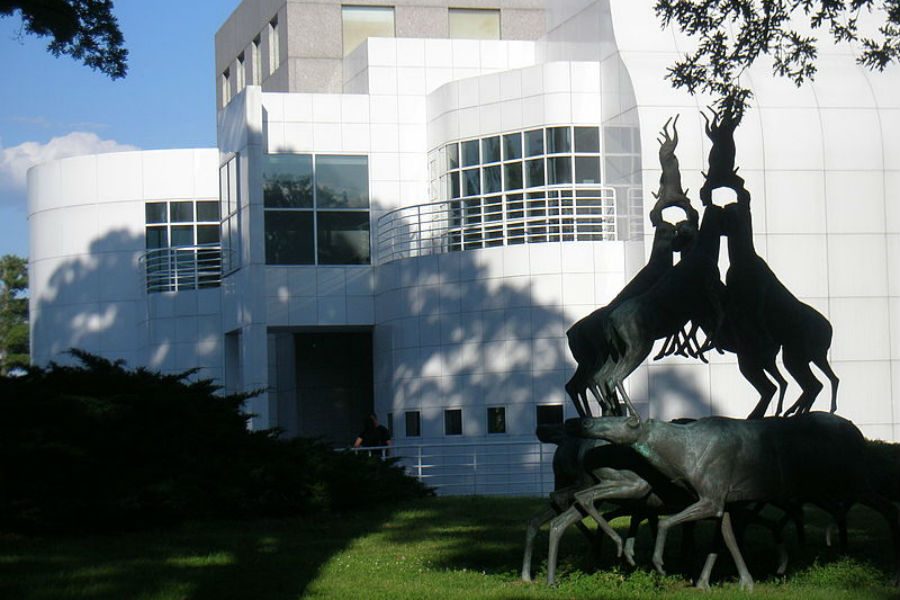The Des Moines Art Center: My Three Favorite Works
Photo by Des Moines Guy
The Des Moines Art Center
The Des Moines Art Center was established in 1948 and currently presents over 5,000 works to the public. This center houses works of art from the 20th and 21st century. Outdoors there is a small park that includes a rose garden and sculptures, along with a trail.
One of my favorite but also one of the hardest paintings for me to look at is titled Three Friends by John Currin. I first looked at this painting my sophomore year of high school (2014) on a field trip with my art class. Due to the matter of the painting (three somewhat juvenile girls, all fully naked, standing and sitting together),I felt a little uncomfortable to judge and understand this painting standing with my art teacher. However, we used it as a discussion that turned into a discussion about issues in the modern world, and at the end I no longer felt awkward or uncomfortable.
On this visit to the art center, I visited this painting once again. As a senior in high school now and a little more aware of events in the real world, I was able to understand what my art teacher had once discussed with us, and apply my own thoughts to it. When we first analyzed this painting, we discussed why the ‘three friends’ were naked. We all decided they were most likely prostitutes. I still believe this is the case; however, I was able to analyze their role in the world more. The painting was done in the 1990’s, a time when young women becoming prostitutes was a rising trend, according to the U.S. Department of Justice. To me, this painting represents the young women in prostitution and the groups that band together in a time like this.
Currently, the Des Moines Art Center has a traveling exhibit entitled ‘Vivian Maier: Through a Critical Lens.’ This is a photography project focusing on street photography in the 1950s and 1960s. What makes this exhibit different than most others is that this series of photos were not intended for public exposure. They were only recently found at an estate sale, then shared to the public without Maier’s permission. While looking through the images, I wondered what her true purpose in taking these pictures was if she did not share them with other people. One of the most interesting images to me is a self-portrait of Maier with a young girl standing beside her. Going into this exhibit I had no background knowledge of Maier. This sparked the question of who the child was, if the girl is still alive and if she is aware of her presence in a traveling art exhibit.
This image, because of the placement of the camera, reminded me of another work of art, Ken Heyman Hip Shots, where the photos are taken from hip level. His photography, just like Maier’s is of unsuspecting people. These photographs always bring up the question of if these are truly ethical. This photograph by Maier was an interesting photo because of the viewpoint and the characters. The fact that it is a black and white picture (due to the technology at that point in time) contributes to the interesting nature of the photograph, because it leaves unanswered questions such as the color of the sky that day, the color of her clothing and the color of their eyes.
These pieces of art at the Art Center relate to this class through both the photography and painting: they are art. Viewing and analyzing these pieces made me appreciate how much information and thought can be provoked and influenced in the viewer. These works can influence different feelings in each viewer, and each viewer most likely sees different things when viewing the art. Personally, thinking about these works made me broaden my knowledge of art and artists in the past years. I do not typically study art, so learning about two famous artists that presented different topics in such different ways is interesting to me.
My favorite part of this experience was viewing all the photography. My plan after high school is to become a photographer, so looking at the viewpoint, setting and characters in these images helps influence my photography in the future. I also enjoyed making up stories to go along with the photos, even though I had no idea what the true story behind the photo was. My least favorite part of the Des Moines Art Center is the set-up of the building. Although every hallway connects to each other, I almost missed a piece of the building that had very influential and interesting art within it. This has nothing to do with the art itself, but it still bothered me I almost missed out on such a large amount of art.
Overall, I would recommend the Des Moines Art Center to every person living within the Des Moines area. It has beautiful, though provoking art, and I thoroughly enjoy my time there.










